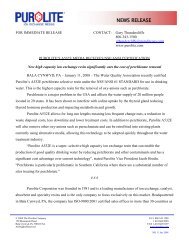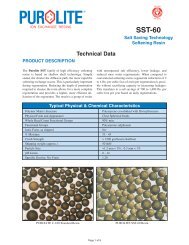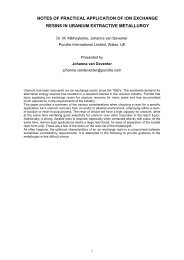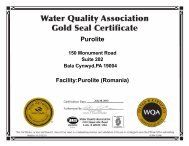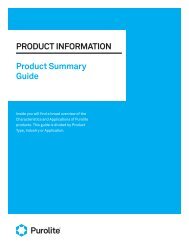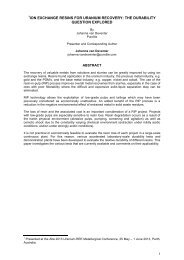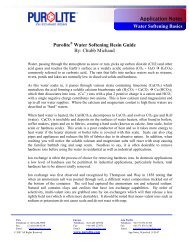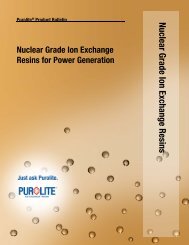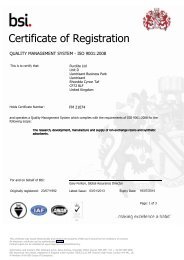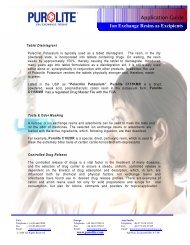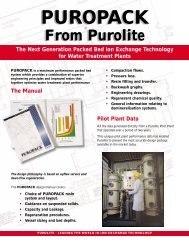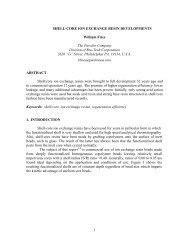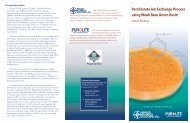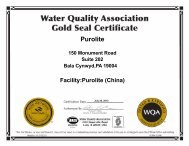Perchlorate Facts for Technology Vendors - Purolite
Perchlorate Facts for Technology Vendors - Purolite
Perchlorate Facts for Technology Vendors - Purolite
You also want an ePaper? Increase the reach of your titles
YUMPU automatically turns print PDFs into web optimized ePapers that Google loves.
Table 1 – Affinity Relative to ChlorideResin Type <strong>Perchlorate</strong> SO4 NO3Gel Acrylic Type I 4 (A-850E) 4 – 5 ~ 11 2Gel Styrenic Type I or II 9 (A-600E, A-300E) 100 – 150 ~ 9.1 3.2Nitrate Selective (A-520E) >200 < 7 < 12BiQuat (A-530E)* >1000 < 6 < 12* a perchlorate selective resin developed and licensed by Oak Ridge National Laboratories(ORNL).”BiQuat” is a trademark of ORNLThe concentration of competing anions such as sulfate, nitrate, chloride and bicarbonateare typically about 1000 times higher than that <strong>for</strong> perchlorate (e.g. 50 ppm versus 50ppb). So despite the higher selectivity <strong>for</strong> perchlorate, a significant fraction of the ionexchange sites on the resin beads will be occupied by these competing ions, leaving littleleft <strong>for</strong> perchlorate. A small change in the concentration of these competing anions canhave a major impact on the resin’s capacity <strong>for</strong> perchlorate.There<strong>for</strong>e, it is critical to know the background water chemistry of the water ifperchlorate capacity is to be assessed (see how to do this later on).QUESTION 4: Which type of resins can be regenerated with brine?Strong base gel Acrylic Type I resins (e.g. <strong>Purolite</strong> A-850E) are economicallyregenerable with salt dosages ranging from 12 to 25 lbs per cubic foot of resin, dependingon system design. It is difficult to economically regenerate other types of resins such asstyrenic type I (e.g. <strong>Purolite</strong> A600E), type II (e.g. <strong>Purolite</strong> A300E) and nitrate selectresins (e.g. <strong>Purolite</strong> A-520E) using brine.The reason should be clear from the affinity data in Table 1 – acrylic resins have a muchlower selectivity <strong>for</strong> perchlorate than other resins, making it much easier to removeperchlorate from the resin with brine. Note that acrylic resins show higher selectivity <strong>for</strong>sulfate than <strong>for</strong> perchlorate (unlike other resins), which means that sulfate will displace orelute perchlorate from the resin as the ion exchange system operates. Thus the capacity ofacrylic resins is largely determined by the amount of sulfate in the water and the point atwhich sulfate breaks from the ion exchange column. This can be seen in Graph 1 below.Sulfate pushes both nitrate and perchlorate of the ion exchange column.In this case, perchlorate is the most selected of all anions considered and perchloratebreaks through in the effluent at about 5,000 bed volumes (note: 1 bed volume isapproximately 7.5 gallons per cubic foot of resin). Effluent and influent levels ofperchlorate equalize at about 15,000 BVs <strong>for</strong> this particular example.Page 2 of 7



